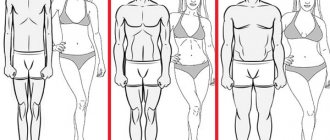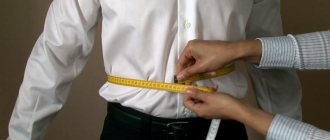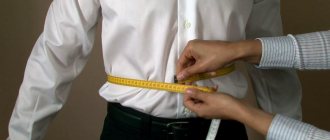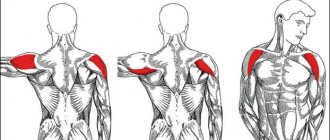In order for clothes to look impressive on you, emphasizing your advantages and hiding flaws, you need to decide on the size. And for this you need to take the measurements correctly. Especially if you want to order an item through an online store. Please note that in this case you will not be able to understand from your own feelings whether this item will be comfortable to wear or whether it is too big/small.
Even if you are sure that you have been size 42 all your life, do not be lazy to take accurate measurements before placing your order. Sizes of clothing for women can differ significantly between imported and domestic manufacturers. Therefore, if you are wondering how to find out your clothing size so as not to make a mistake, this material is just for you.
To sew which clothes will you need to measure your hip circumference?
There are several ways to measure hip volume. Taking measurements is necessary if a person plans to sew clothes on his own or to order in a studio. In the process, they take into account the protrusion of the abdomen and focus on the protruding points of the buttocks. In order not to make mistakes in the calculations, it is necessary to correctly position the tailoring tape.
Hip circumference is required when sewing skirts, trousers and coats
Measuring the hip circumference is necessary for sewing various waist products:
- coats (balmakaans, peacoats, dusters, invernesses, capes, covercoats, copars, crombies, down jackets, raglans);
- raincoats (mackintoshes, gubertuses, raincoats, trench coats, capes);
- trousers (cargo, flared, culottes, leggings, leggings, palazzo, leggings, skinny, slacks, jeans, capris, joggers);
- skirts (straight, slanting, wraparound, tapered, conical).
Measuring your hip circumference may be necessary when sewing jackets, cardigans and other outerwear.
How to measure your hips correctly
Today, people make most of their purchases in online stores. In order not to make a mistake with the size, you need to know at least the waist and hip circumference. The most convenient way to take measurements is with a special tape. You can ask family members for help. It will be easier to take measurements together.
To a woman
You can measure your hip volume using a tailor's tape. If you plan to sew trousers, then you also need to find out their height.
Algorithm for taking measurements:
- go to the mirror, stand in front of it at full height;
- turn your face to the mirror, join your legs together, straighten your shoulders;
To take measurements you will need a measuring tape
- pick up a tailor's yardstick;
- wrap it correctly around your hips;
- record the result.
You should definitely take your measurements in front of a mirror. Reflection will help you evaluate your own body parameters. You can also see how the centimeter “lies” in front of the mirror. If it is skewed, the result may not be accurate.
You need to take your measurements after all outer clothing has been removed. The accuracy of the result will not be affected by the presence of underwear. There is no need to get rid of it.
There is no need to place your feet shoulder-width apart. It is recommended to place them as close to each other as possible. Wide-set legs can add volume. It is also necessary to understand the difference between the hips and the waist. The natural waist is the most sunken and narrow part of the body. The hips are located below this “notch”.
How to measure your hips
When measuring volume, the buttocks are also taken into account. To take a measurement, you need to find the widest point. This will allow you to obtain the most reliable data. The tailor's meter should be moved a few centimeters down from the waist.
The measuring tool must be applied to the central axis of the torso and wrapped around the torso. The tailor's tape measure should also include the buttocks. Experts recommend looking in the mirror once again to make sure that the tape is not twisted. The measuring instrument should fit as closely as possible to the body. It shouldn't tighten the skin too much.
The tape is considered to be correctly applied if a finger fits comfortably between it and the thigh. To find out the volume of the hips, you need to look at the number located at the junction of the metal tip and the rest of the tape.
When sewing clothes, experienced tailors usually add 2-3 cm to the obtained values. This will ensure a looser fit of the item to the body.
To a man
You can measure hip volume in men using auxiliary tables. They indicate approximate values according to height. The male figure is different from the female one - their hips are narrower than their shoulders. The algorithm for taking measurements is standard.
Necessary:
- go to the mirror (preferably full-length), pick up a tailor's tape measure, find the widest part of the hips;
- wrap a measuring tape around it;
- record the received data.
You can take measurements yourself, without the help of others. It is important to constantly ensure that the tape does not twist. It is recommended to bring your legs together. You need to get rid of any outerwear (pants, shorts). There is no need to take off your underwear.
How to measure a man's hips and waist
The tailor's tape measure should not tighten the skin. It is necessary that the index finger fits freely between the tape and the thigh. When taking measurements, there is no need to strain your muscles. The person must be completely relaxed.
To kid
It is quite difficult to take measurements from small children, so experts recommend using special tables that indicate the child’s size by age.
Typology:
- newborn group;
- nursery group;
- preschool group;
- junior school group;
- secondary school group;
- senior school group;
- teenage group.
In infants, size is determined by weight and height. When working with tables, it is also necessary to take into account an additional feature - the presence of completeness. Children over 3 years old are measured using tape.
If the child is small, you must adhere to a number of rules:
- It is better to take measurements from children under 2 years old together (one person measures the hip volume, the second holds the child in a stationary position);
- it is not necessary to bring it to the mirror (usually measuring the hip circumference in children under 3 years of age is carried out lying down).
Taking measurements from school-age children and teenagers is quite simple:
- you need to ask the child to stand up straight, bring his heels together and lower his arms;
- find the wide part of the thigh and wrap it with tailor’s braid;
- record the received data.
How to measure hip volume for children
An error of no more than 2-3 mm is allowed. You need to make sure that the tailoring tape does not twist or squeeze the skin.
Character.
Women with a wider waist are characterized by “masculine behavior.” Visceral obesity is associated with an increase in testosterone. And for men it’s the opposite. According to Cashdan, in countries where women occupy a subordinate position in economic terms (Japan, Portugal, Greece), thin waists are more common among local residents. In countries with pronounced gender equality (Denmark, Great Britain) the situation is exactly the opposite.
How to take measurements without a centimeter
You can simply measure your hip circumference using thread. For this you will need a ruler. The thread is wrapped around the hips and the excess is cut off. To find out the length of the thread, just attach it to a ruler.
The products selected as meters should not be of any value, because they will need to be shortened or marked in the process. Most likely, after the procedure, the improvised centimeter will have to be thrown away. If you don’t have a ruler at hand, you can pay attention to objects with straight edges.
Look for something flexible for taking measurements.
Find an object with exactly known length
Apply a scale with centimeter marks to the selected material for measurements
Measure your hips
For example, an A4 sheet - its length is 29.7 cm, width - about 21 cm. Banknotes in denominations of 500 and 100 rubles. standard sizes - length - 15 cm, width - 6.5 cm. A scale must be applied to the material selected as a meter. Experts recommend marking every centimeter - this will allow you to take measurements as accurately as possible.
Basic rules to follow when measuring your hips
You can measure your hip volume as accurately as possible if you take the correct position. Measurements may turn out to be “floating” if you use a measuring tape with incorrect divisions in the process.
Experts also recommend paying attention to the time of day. It is preferable to take measurements in the morning or afternoon. At sunset, natural light will be dim; measurements are usually not taken in the evening. To consider all the features of the figure, it is necessary to place several additional lighting sources in the room.
For these purposes, lamps that emit soft light are used. They are installed at a short distance from the mirror. Experts recommend removing clothes and preparing the necessary measuring equipment before trying on.
So that clothes don't get in the way
Measuring the volume of the hips, waist or other parts of the body must be done correctly. Experts recommend removing all clothing before trying on. If you wrap tailor's tape around fabric (trousers, skirts, tunics), the readings may be distorted.
There is no need to take off your underwear. Women can remain in a thin slip, provided that the fitting takes place in an atelier or other public places. Shirts are usually made of chiffon, crepe de Chine or silk. In this case, it is necessary to subtract 1-2 cm from the obtained indicators.
Measurements are taken wearing only underwear and always standing
Especially for such cases, you can purchase a slimming shirt. Such combinations are made of thin, elastic material. The shirt fits tightly to the body and usually has chiffon or lace inserts in the hip area.
During fitting, a man can remain in thin underwear. Trousers, long johns, shorts and other clothing must be removed. Particularly shy men can wear thin gaiters or tights. In this case, you need to subtract 1-1.5 cm from the obtained values.
Use a mirror
To assess the strengths of a figure and identify possible shortcomings, measurement of hip volume in men and women is carried out in front of a mirror. It is advisable that the object in which people see their reflection be placed in a living space. In fitting rooms, studios, and shopping centers, mirrors are usually installed that visually make you look slimmer.
You need to take measurements in front of a mirror
You need to take measurements in front of a mirror to get the most accurate result. If the tape wrapped around the hips gets twisted, the readings may increase by several centimeters.
Standing in front of the mirror, first of all you need to determine the maximum high point. This is quite easy to do. To be sure, you need to measure several times. This will allow you to get accurate indicators. Also, the final result depends on the position of the body.
Recommendations
The tips below will help you take measurements as accurately as possible:
- Professional athletes need to determine progress using measurements once a week. It's best to do this on Friday.
- You need to apply the centimeter in the same place. Otherwise, the results will vary.
- Each parameter should be measured at least three times. This will avoid incorrect indicators.
- The measurement procedure is best done in the morning on an empty stomach. At this time, the muscles are relaxed and have a natural shape.
To record your progress, keep a diary. Write down the results of each check in it, and also attach your own photographs. All this will help track the growth of muscle mass and will further motivate you to exercise.
Correct body position
It is necessary to measure the volume of the buttocks and hips while standing. Experts recommend taking measurements in a bright, spacious room. It is advisable to choose a full-length mirror. You can place several lamps nearby that emit soft light (especially if measurements are taken in the evening).
When taking measurements, the legs are placed together and straight
Before taking measurements, you need to remove all outer clothing, remaining in your underwear. You need to stand straight in front of the mirror with your heels together. It is not recommended to place your feet shoulder-width apart. In this case, the volume of the hips will increase in direct proportion to the distance from the right leg to the left. While taking measurements, you should try to keep your back straight.
How to easily determine the widest part of your hips
When sewing outerwear or waist items (shorts, trousers, leggings, jeans, skirts), several anthropometric points are found on the human body. This is necessary for the item to fit perfectly to your figure.
You need to determine:
- Gluteal point. A tailor's tape measure is wrapped around the protruding part of the buttocks (approximately in the middle).
- Pelvic point. The tailoring tape is lowered to how many centimeters below the waist (approximately under the thigh bone).
- Femoral point. The tailor's meter should be lowered 4-5 cm below the pelvic point.
To measure OB, you need to wrap a measuring tape around the protruding part of the buttocks.
Experts recommend recording all received readings. For accuracy, you can measure the same body part several times. In addition to the hip circumference, to sew outerwear you also need to measure the height, second girth and half-circumference.
To find out a person's OB, you need to wrap a tailor's tape measure around the protruding part of the buttocks. The height of the hips is measured from the side: a tailor's centimeter is applied to the waist and lowered to the hip.
To measure the second girth, you need to find the so-called “breeches” (there are fat deposits on the outer side of the thigh). It is around them that you need to wrap the tailor's centimeter.
Cancer in hormonal-dependent organs (breast and prostate).
The accumulation of fat deposits around the waist over a lifetime is directly linked to an increased risk of breast cancer after menopause, British researchers have found. Statistical analysis showed that the rate of increase in skirt size between 25 and 55 years of age is a clear indicator of the risk of developing the disease later in life: increasing waist circumference by one size every ten years increases this probability by 33 percent, and by two sizes increases this probability by 77 percent. .
Research shows that women whose WHR remains in the 0.7 range have optimal estrogen levels and are less susceptible to diabetes, cardiovascular disease and genital cancer. Men with a WHR of approximately 0.9 have good potency. These men have a low risk of developing prostate cancer.
Determining clothing size by hip circumference
To determine the exact size of clothing, it is necessary to correctly measure the horizontal girth of the desired part of the body. Results may be rounded according to typical clothing characteristics. It is not recommended to rely on labels, even if the item fits well.
Determining clothing size by hip circumference
When rounding parameters down, you need to remember that the finished garment will fit tightly to the silhouette. If the values have been rounded up, then the item will “sit” loosely. The sizes of men's and women's clothing (according to hip volume) are indicated in the table.
Women's sizes
According to anthropometric standards, the female figure is divided into several types. Their dimensional characteristics vary.
Main features:
- hip circumference (half circumference is not taken into account);
- chest girth (third option, Og3);
- height.
Female figures are divided into several complete groups. They can be determined by simple mathematical operations: it is necessary to subtract the values of Og3 from the OB indicators.
Body types
The following standards were adopted in the CIS:
- First group. The difference between hip volume and chest volume is 1-2 cm.
- Second group. The difference between hip volume and chest volume is 5-6 cm.
- The third group, the difference between the volume of the hips and the volume of the chest is 9-10 cm.
- Fourth group. The difference between hip volume and chest volume is 13-14 cm.
- Fifth group. The difference between hip volume and chest volume is 18 cm.
Sixth group (zero completeness). The difference between hip volume and chest volume is 2 cm.
Table of sizes of women's skirts, trousers, shorts according to hip volume (other indicators are also indicated):
| Sizes in CIS countries | Int (international format) | Hip volume | Waist | Bust volume |
| 70 | 5XL | 141-144 cm | 137-140 cm | 140-143 cm |
| 68 | 5XL | 137-140 cm | 131-134 cm | 136-139 cm |
| 66 | 5XL | 134-136 cm | 127-130 cm | 132-135 cm |
| 64 | 4XL | 131-134 cm | 124-126 cm | 128-131 cm |
| 62 | 4XL | 128-131 cm | 118-121 cm | 124-127 cm |
| 60 | 4XL | 125-128 cm | 112-115 cm | 120-123 cm |
| 58 | XXXL | 122-125 cm | 108-111cm | 116-119 cm |
| 56 | XXL | 119-122 cm | 104-107 cm | 112-115 cm |
| 54 | XXL | 116-119 cm | 100-103 cm | 108-111 cm |
| 52 | XL | 113-116 cm | 94-97 cm | 103-107 cm |
| 50 | L | 110-113 cm | 92-94 cm | 99-102 cm |
| 48 | L | 107-110 cm | 90-93 cm | 95-98 cm |
| 46 | M | 104-107 cm | 84-87 cm | 91-94 cm |
| 44 | M | 101-104 cm | 80-83 cm | 87-90 cm |
| 42 | S | 98-101 cm | 64-67 cm | 83-86 cm |
| 40 | XS | 95-98 cm | 60-63 cm | 79-82 cm |
| 38 | XXS | 92-95 cm | 56-59 cm | 75-78 cm |
The measurements of the waist, hips and chest may vary depending on the individual characteristics of the female figure.
Men's sizes
Male figures are also classified according to the type of fullness.
To determine it, you need to subtract the waist measurements from the chest volume values:
- First group. The difference between chest and waist volume is 21-22 cm.
- Second group. The difference between chest and waist volume is 15-16 cm.
- Third group. The difference between chest and waist volume is 9-10 cm.
- Fourth group. The difference between chest and waist volume is 3-4 cm.
- Fifth group. The difference between bust and waist volume is 1-2 cm.
Groups are arranged in descending order. Negative values are achieved due to the characteristic excess of OT to Og3 indicators.
Dimensions for men's shorts and trousers:
| Size (standard designation) | Hip volume | Waist |
| 68 | 134-137 cm | 122-125 cm |
| 66 | 131-134 cm | 119-122 cm |
| 64 | 128-131 cm | 116-119 cm |
| 62 | 125-128 cm | 113-116 cm |
| 60 | 122-125 cm | 110-113 cm |
| 58 | 118-122 cm | 107-110 cm |
| 56 | 115-118 cm | 104-107 cm |
| 54 | 112-115 cm | 101-104 cm |
| 52 | 109-112 cm | 108-101 cm |
| 50 | 106-109 cm | 105-108 cm |
| 48 | 103-106 cm | 102-105 cm |
| 46 | 100-103 cm | 99-102 cm |
| 44 | 97-100 cm | 96-99 cm |
It should be remembered that the main indicator when choosing shirts, sweaters and shirts is chest girth.
Concept of figure measurements
To build the basic design of clothing, you need to have from 8 to 20 different measurements, standard or taken from a specific figure, depending on the construction method.
Typical figures of men and children are characterized by three main features: height, chest and waist circumference. Hip circumference is an additional feature that correlates with the waist. In men's clothing, even trousers, the main measurement that determines the size of the product is the waist size. Hips in men and children are measured depending on individual circumstances.
The fullness group shows the proportions, the ratio of the girths of the upper and lower parts of the human body. Understanding the completeness is important for choosing a methodology and calculation formulas for construction. When choosing a finished product, it is necessary to take into account the body proportions laid down by the manufacturer. The fit of clothes on the figure largely depends on them: the balance of top and bottom in sets, fit in dresses and overalls. The complete group of products for men and children depends on the proportion of chest and waist volumes. It is determined by simple mathematical subtraction of one dimension from another. For example:
Children's sizes
When choosing children's clothing, it is necessary to take into account the height and weight of the child. Newborns usually buy things 1-2 sizes larger.
Dimensional characteristics:
| Child's age | Weight | Height | Hip volume | Waist | Bust volume | Size |
| 12 years | 34-37 kg | 150-153 cm | 80-81 cm | 80-81 cm | 80-81 cm | 38 |
| 11 years | 32-35 kg | 144-147 cm | 74-79 cm | 74-79 cm | 74-79 cm | 36 |
| 10 years | 30-33 kg | 140-142 cm | 70-74 cm | 70-74 cm | 70-74 cm | 34 |
| 9 years | 28-31 kg | 132-135 cm | 68-73 cm | 68-73 cm | 68-73 cm | 32 |
| 8 years | 26-29 kg | 126-129 cm | 65-69 cm | 65-69 cm | 65-69 cm | 32 |
| 7 years | 24-27 kg | 120-123 cm | 62-65 cm | 62-65 cm | 62-65 cm | 30 |
| 6 years | 22-25 kg | 114-118 cm | 56-60 cm | 56-60 cm | 56-60 cm | 30 |
| 5 years | 20-23 kg | 110-112 cm | 54-58 cm | 54-58 cm | 54-58 cm | 28 |
| 4 years | 17-19 kg | 107-110 cm | 52-55 cm | 52-55 cm | 52-55 cm | 28 |
| 3 years | 15-17 kg | 105-108 cm | 50-53 cm | 50-53 cm | 50-53 cm | 26 |
| 2 years | 13-15 kg | 97-100 cm | 49-51 cm | 49-51 cm | 49-51 cm | 26 |
| 1 year 6 months | 10-12 kg | 85-89 cm | 46-48 cm | 46-48 cm | 46-48 cm | 24 |
| 1 year | 8-10 kg | 79-83 cm | 43-45 cm | 43-45 cm | 43-45 cm | 24 |
| 6-9 months | 6-8 kg | 72-75 cm | 40-42 cm | 40-42 cm | 40-42 cm | 22 |
| 3-6 months | 5-7 kg | 69-71 cm | 38-40 cm | 38-40 cm | 38-40 cm | 22 |
| 90 days | 4.5-6 kg | 62-65 cm | 36-39 cm | 36-39 cm | 36-39 cm | 20 |
| 60 days | 4-5 kg | 53-56 cm | 35-37 cm | 35-37 cm | 35-37 cm | 18 |
| 30 days | 3.5-4.5 kg | 50-53 cm | 33-35 cm | 33-35 cm | 33-35 cm | 18 |
When choosing children's clothing, you need to pay special attention to the quality of the material. Synthetic fabric may cause an allergic reaction.
Parameters of famous athletes
Values are given in centimeters and kilograms:
| Athlete | Height Weight | Neck | Biceps | Breast | Waist | Hip | Shin |
| A. Schwarzenegger | 188/115 | – | 56 | 145 | 81 | 71,5 | 50,5 |
| Lou Ferrigno | 197/118 | – | 55 | 145 | – | 74 | 48 |
| I. Poddubny | 184/120 | 50 | 45 | 134 | 104 | 70 | 47 |
| G. Gakkenshmidt | 176/93 | 50 | 47 | 125 | 85 | 68 | – |
| D. Yates | 181/114 | – | 57,5 | 145 | – | – | 55 |
| S. Oliva | 179/102 | – | 54 | 140 | 75 | 73 | 47 |
How to calculate Sat
If a person is not overweight, then simply wrap the tailoring tape around the back of the thigh so that it closes on the right side in front. The method is suitable for people with a flat stomach.
If you are overweight, you can measure your hip circumference as follows:
- wrap a lace or thick thread around your hips;
- make marks on the right and left sides, exactly in the center;
- cut off excess (ends of twine);
- measure the length of the remaining part of the lace.
First you need to find the highest part of the buttocks. Typically, a tailor's tape measure is wrapped around the convex part of the hips (the tape is placed a few centimeters below the waist). Also, when sewing clothes, you may need hip length.
Many people mistakenly wrap the tailoring tape around one thigh. It is necessary to visually divide the side of the thigh into 2 parts and mentally mark the central point. Place the metal end (the beginning of the sewing tape measure) at one point and stretch the tailor's tape to another point. Write data.
You need to measure the volume and semi-circumference of your hips correctly so that your custom-made clothes fit perfectly. To obtain accurate indicators, measurements are taken in front of a mirror. It is advisable to remove all outer clothing, leaving only a thin shirt or underwear. It is not recommended to eat before measurement.
Cardiovascular health.
Waist size quite reliably indicates an increased risk of hypertension, diabetes and high cholesterol. Studies have confirmed that health risks begin to increase if a woman's waist reaches 80 centimeters; at 89 centimeters it increases significantly. For men, the risk increases from 94 centimeters. Then we will talk about adjusting for height, because these are relative figures, and they are not suitable for people who are too tall or too short, for children, and also for representatives of some ethnic groups. For example, among the Japanese, the risk increases sharply if the waist size in men reaches 85 centimeters, and in women - 90 centimeters. The risk of stroke is increased sevenfold.











